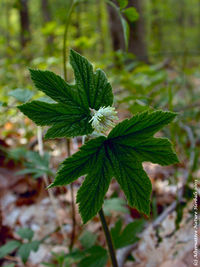Hydrastis canadensis
| See Also | Botanical Monographs |
|---|
Goldenseal (Hydrastis canadensis) has also traditionally been used for stomach and liver problems. To explore the characteristics, medicinal uses and prescribing considerations of this herb in more detail, check out the references indicated.[1], [2]
Contents
Characteristics
- Common Names: Goldenseal, Orange root, Yellow root, Ground raspberry, Indian turmeric, Eye root, Jaundice root, Indian dye, Yellow puccoon, Turmeric root
- Family: Berberidaceae/Ranunculaceae
- Habitat: Hydrastis is native to North America, prefers shady woods and rich moist soil, and is mostly cultivated. The species is considered "at risk".
- Parts Used: Root, rhizome
- Constituents: Isoquinoline alkaloids (hydrastine and berberine)
- Medicinal Actions: Tonic for nervous, reproductive, respiratory, and cardiac system; mucous membrane tonic, (King of the mucous membranes) and muscle tonic; spasmolytic, anticonvulsant, CNS and uterine sedative, uterotonic, stimulates the uterus, oxytocic, pectoral, astringent, uterine antihaemorrhagic, anticatarrhal, cholagogue, bitter, laxative, decongestant, antimicrobial, alterative, antitussive, emmenagogue, expectorant, hepatic, oxytonic, vulnerary
Uses
Historical Uses:
Hydrastis canadensis was used by the Cherokee as an insect repellant. It has also traditionally been used for stomach and liver problems.
Medicinal Uses:
- catarrhal states of mucous membranes without presence of acute inflammation, upper respiratory tract infections where gelatinous mucous drops into the throat, good for the mucous membranes of the digestive tract, upper respiratory tract, and the genitourinary tract
- atonic dyspepsia with hepatic symptoms, gastritis, loss of appetite, colitis
- Other Conditions
- eczema, ringworm, pruritus, diabetes mellitus, menorrhagia, postpartum hemorrhage, vaginal infections, leucorrhea (soak tampon in tea)
Prescribing Considerations
The information provided is intended to augment the treatment from a naturopathic doctor or other trained medical professional. Although most herbs are generally safe, it is recommended that you avoid self-prescribing especially when there is an underlying ongoing medical condition, if you are on any prescription medications or if you are pregnant or breastfeeding.
Formulations and Preparation
- Powdered root infusion - 1/2-1 tsp/cup three times daily
- Tincture - 1-4mL (1:5, 60%) three times daily
- Liquid extract (1:1 in 60% ethanol) - 0.3-1mL three times daily
- Solid extract (4:1) - 250mg three times daily
- Standardized extract (to 5% hydrastine) - 250-500mg three times daily
Safety
The safety and prescribing considerations for this herb include:[3] [4]
- Generally regarded as safe.
- Side-effects are few when taken at therapeutic doses. These may include gastrointestinal irritation (from the bitters), may reduce vitamin B absorption, and prolonged use may disturb balance of bowel flora. There is potential of poisoning.
- Cautions and Contraindications: pregnancy (berberine is a uterine stimulant), lactation (toxic, jaundiced newborn), acute inflammation, locally for purulent ear discharge (possible ruptured drum, speculative), kidney disease or failure (inadequate urinary excretion of alkaloids, empirical), hypertension (speculative), acute stomach inflammation (enhanced gastric acid secretion, empirical)
- Drug-Herb Interactions.[2]
- Sulphacetamide Eye Drops - Co-administration eliminated inclusion bodies of Chlamydia trachomatis (human study)
- Barbiturates - Potentiates
References
- ↑ Boon Heather, Smith Michael (2009) 55 Most Common Medicinal Herbs: The Complete Natural Medicine GuideSecond Edition Institute of Naturopathic Education and Research, CCNM Toronto.
- ↑ 2.0 2.1 Godfrey Anthony, Saunders Paul, Barlow Kerry, Gowan Matt (2011) Principles and Practices of Naturopathic Botanical Medicine, Advanced Botanical Medicine. V3 CCNM Press, Toronto.
- ↑ Stargrove Mitchell Bebell, Treasure Jonathan, McKee Dwight L (2008) Herb, Nutrient and Drug Interactions: Clinical Implications and Therapeutic Strategies.
- ↑ Brinker Francis (1997) Herbal Contraindications and Drug Interactions: Plus Herbal Adjuncts With Medicines, 4th Edition Eclectic Medical Publications.
